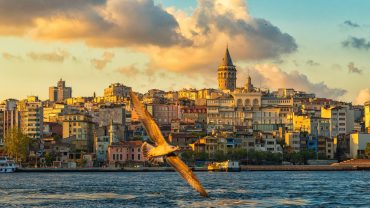
Konya (Turkish pronunciation: [ˈkon.ja]) is a major city in south-central Turkey, on south-western edge of the Central Anatolian Plateau and is the seventh-most-populous city in Turkey with a metropolitan population of over 2.2 million. Konya is a large and industrially developed city and the capital of Konya Province.
The Konya region has been inhabited since the 3rd millennium BC. Known as Iconium during classical antiquity, the city was ruled successively by the Phrygian, Persian, Hellenistic and Roman civilizations. In the 11th century the Seljuk Turks conquered the area from the Byzantines, and Konya then became the capital of the Sultanate of Rum. Under the Seljuks, the city reached the height of its wealth and influence. Following the demise of Rum, Konya came under the rule of the Karamanids, before being taken over by the Ottoman Empire in the 15th century. After the Turkish War of Independence the city became part of the modern Republic of Turkey.
Name
Konya was known in classical antiquity and during the medieval period as Ἰκόνιον (Ikónion) in Greek (with regular Medieval Greek apheresis Kónio(n)) and as Iconium in Latin. Ikónion is merely the Hellenization of an older Luwian name Ikkuwaniya.
By some the name Ikónion is commonly explained as a derivation from εἰκών (icon), as an ancient Greek legend ascribed its name to the “eikon” (image), or the “gorgon’s (Medusa’s) head”, with which Perseus vanquished the native population before founding the city.
According to the Suda, Perseus after he married Andromeda founded the city and called it Amandra (Ἄμανδραν) and the city had a stele depicting the Gorgon. The city later changed the name to Ikonion because it had the depiction (ἀπεικόνισμα) of the Gorgon.
In some historic English texts, the city’s name appears as Konia or Koniah.
History
Ancient history
Excavations have shown that the region was inhabited during the Late Copper Age, around 3000 BC. The city came under the influence of the Hittites around 1500 BC. Later it was overtaken by the Sea Peoples in around 1200 BC.
The Phrygians established their kingdom in central Anatolia in the 8th century BC. Xenophon describes Iconium, as the city was called, as the last city of Phrygia. The region was overwhelmed by Cimmerian invaders c. 690 BC. It was later part of the Persian Empire, until Darius III was defeated by Alexander the Great in 333 BC. Alexander’s empire broke up shortly after his death and the town came under the rule of Seleucus I Nicator. During the Hellenistic period the town was ruled by the kings of Pergamon. As Attalus III, the last king of Pergamon, was about to die without an heir, he bequeathed his kingdom to the Roman Republic. Once incorporated into the Roman Empire, under the rule of emperor Claudius, the city’s name was changed to Claudioconium, and during the rule of emperor Hadrianus to Colonia Aelia Hadriana.
According to the Acts of the Apostles, the apostles Paul and Barnabas preached in Iconium during their first Missionary Journey in about 47–48 AD, having been persecuted in Antioch, and Paul and Silas probably visited it again during Paul’s Second Missionary Journey in about 50. Their visit to the synagogue of the Jews in Iconium divided the Jewish and non-Jewish communities between those who believed Paul and Barnabas’ message and those who did not believe, provoking a disturbance during which attempts were made to stone the apostles. They fled to Lystra and Derbe, cities of Lycaonia. This experience is also mentioned in the Second Letter to Timothy,. 19th century American theologian Albert Barnes suggested that Timothy had been present with Paul in Iconium, Antioch and Lystra. The city became the seat of a bishop, which in ca. 370 was raised to the status of a metropolitan see for Lycaonia, with Saint Amphilochius as the first metropolitan bishop.
In Christian legend, based on the apocryphal Acts of Paul and Thecla, Iconium was also the birthplace of Saint Thecla, who saved the city from attack by the Isaurians.
Under the Byzantine Empire, the city was part of the Anatolic Theme. During the 8th to 10th centuries, the town and the nearby (Caballa) Kaballah Fortress (Turkish: Gevale Kalesi) (location) were a frequent target of Arab attacks as part of the Arab–Byzantine wars.
Seljuk era
The Seljuk Turks first raided the area in 1069, but a period of chaos overwhelmed Anatolia after the Seljuk victory in the Battle of Manzikert in 1071, and the Norman mercenary leader Roussel de Bailleul rose in revolt at Iconium. The city was finally conquered by the Seljuks in 1084. From 1097 to 1243 it was the capital of the Seljuk Sultanate of Rum. It was briefly occupied by the Crusaders Godfrey of Bouillon (August 1097), and Frederick Barbarossa (May 18, 1190) after the Battle of Iconium (1190). The area was retaken by the Turks.
Konya reached the height of its wealth and influence in the second half of the 12th century when the Seljuk sultans of Rum also subdued the Anatolian beyliks to their east, especially that of the Danishmends, thus establishing their rule over virtually all of eastern Anatolia, as well as acquiring several port towns along the Mediterranean (including Alanya) and the Black Sea (including Sinop) and even gaining a momentary foothold in Sudak, Crimea. This golden age lasted until the first decades of the 13th century.
Many Persians and Persianized Turks from Persia and Central Asia migrated to Anatolian cities either to flee the invading Mongols or to benefit from the opportunities for educated Muslims in a newly established kingdom.
Ottoman era
During Ottoman rule, Konya was administered by the Sultan’s sons (Şehzade), starting with Şehzade Mustafa and Şehzade Cem (the sons of Sultan Mehmed II), and later the future Sultan Selim II. Between 1483 and 1864, Konya was the administrative capital of Karaman Eyalet. During the Tanzimat period, as part of the vilayet system introduced in 1864, Konya became the seat of the larger Vilayet of Konya which replaced Karaman Eyalet.
Turkish War of Independence
Konya had a major air base during the Turkish War of Independence. In 1922, the Air Force was renamed as the Inspectorate of Air Forces and was headquartered in Konya. The Third Air Wing of the 1st Air Force Command is based at the Konya Air Base. The wing controls the four Boeing 737 AEW&C Peace Eagle aircraft of the Turkish Air Force.
Population exchange between Greece and Turkey
In 1923 in the frame of the population exchange between Greece and Turkey, the Greeks that inhabited Konya left as refugees and settled in Greece. At the same time, a significant influx of Albanians came and settled in the area.
Geography
Konya is the center of the largest province, the largest plain (Konya Plain) and is among the largest cities in the country. It is the seventh most populated city in Turkey.
The city is in the southern part of the Central Anatolia Region. The land is broad and flat with a lot of lowlands and plateaus. The plateaus are covered with rich steppes, therefore, affecting the agriculture sector. Additionally, the southernmost part of Konya is largely surrounded by the Taurus Mountains.
The city and the southern parts of the greater Konya enjoy abundant sunshine across the country, resulting in big potential in solar farming. The largest solar farm of Turkey is located 20 miles west of the city.
Lakes
Lake Tuz, known in Turkish as Tuz Golu, is the second-largest lake in all of Turkey. This lake supplies Turkey with a large amount of Turkey’s salt demand.
Beysehir Lake is on the western part of Konya and is near the border. It is known to be the largest fresh water lake in Turkey and one of the most important national parks. Beysehir Lake is important for tourism in Konya and attracts thousands of people each year to its 2 beaches and 22 islands for water and mountain sports.
Meke Lake is on the border of the Karapinar province and is considered to be a heavily protected natural area.
Lake Aksehir is on the border of the Afyon Karahisar province and it is famous from “Nasreddin Hodja” stories. The lake also provides a good habitat for famous “Aksehir cherries”.
Climate
Konya has a cold semi-arid climate (BSk) under the Köppen classification and a hot summer continental (Dca) or hot summer oceanic (Doa) climate under the Trewartha classification.
Summers temperatures average 30 °C (86 °F). The highest temperature recorded in Konya was 40.6 °C (105 °F) on 30 July 2000. Winters average −4.2 °C (24 °F). The lowest temperature recorded was −26.5 °C (−16 °F) on 6 February 1972. Due to Konya’s high altitude and its dry summers, nightly temperatures in the summer months are cool. Precipitation levels are low, but precipitation can be observed throughout the year.
Transportation :
Bus
The bus station has connections to a range of destinations, including Istanbul, Ankara and İzmir.
Tram
Konya has a tramway network in the city center, on which the Škoda 28 T trams are being used. The Konya Metro is currently in the planning and development phase and is slated for construction starting in 2020.
Railway
Konya is connected to Ankara, Eskişehir and Istanbul via the high-speed railway services of the Turkish State Railways.
Airport
Konya Airport is a public airport and military airbase that is also used by NATO. In 2006, Konya Airport served 2,924 aircraft and 262,561 passengers.
Main sights
Sille, 8 kilometres (5.0 miles) northwest from Mevlana Museum: antique village, mosques, churches, cave churches and catacombs
Ince Minaret Medrese—Museum
Karatay Medrese—Museum
Konya Ethnography Museum
Konya Archaeological Museum
Atatürk’s House Museum
Mevlâna Museum





Comment (0)